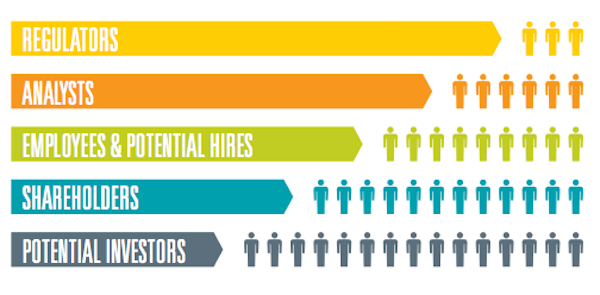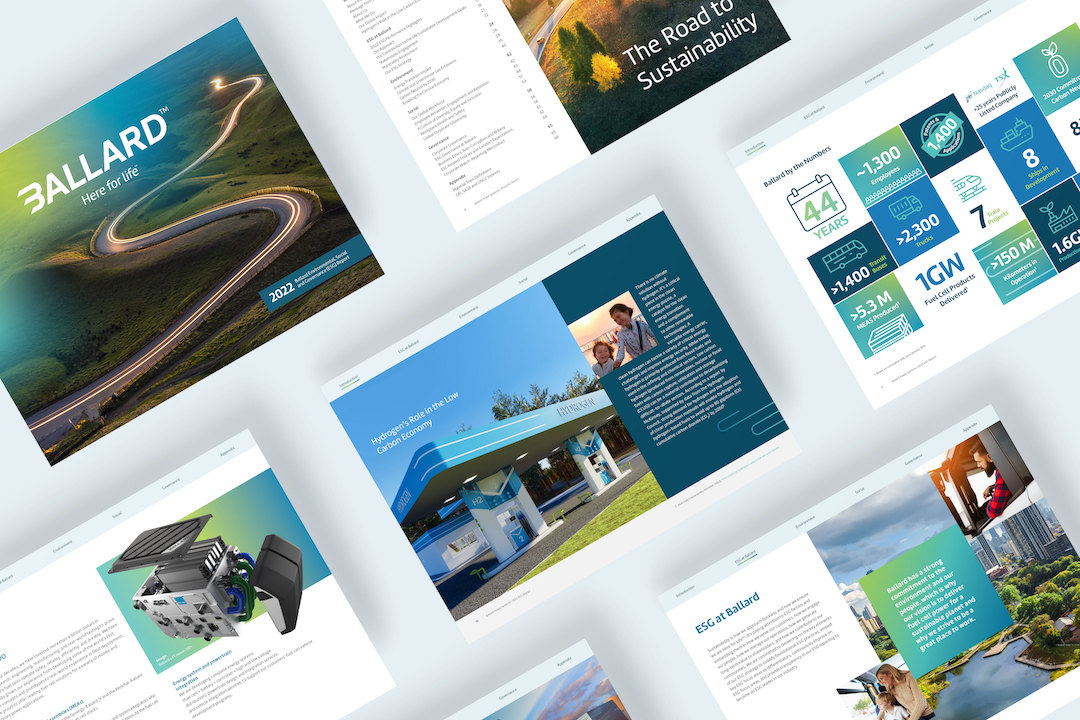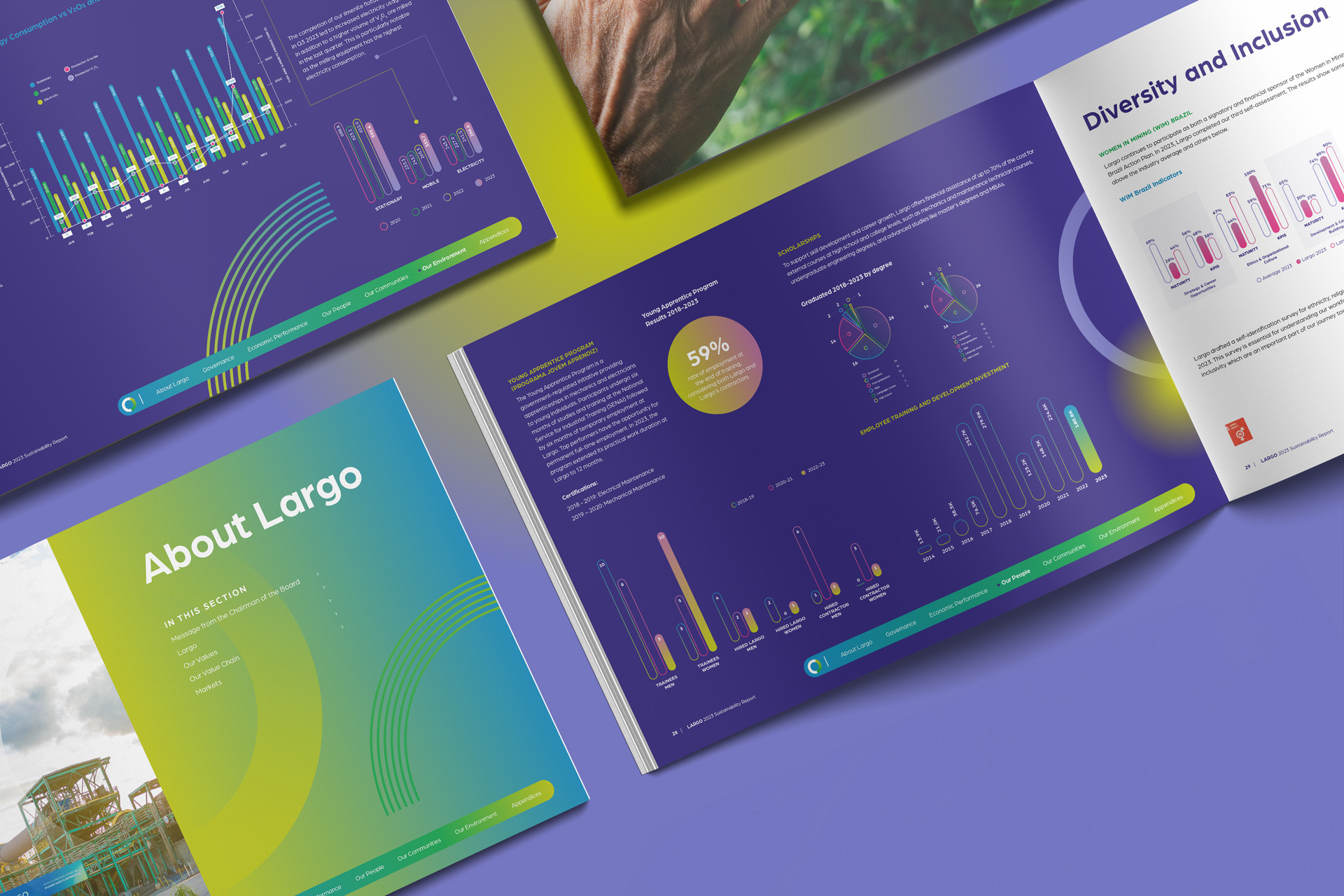The design of sustainability reports has evolved. Rather than being mere compilations of data, these reports have become powerful storytelling tools. By combining inspiring narratives with compelling data, these reports enable companies to showcase their commitment to sustainability, engage stakeholders, and drive positive change.
In this article, we delve into the art of telling the right story in annual sustainability, CSR and ESG (Environmental, Social, and Governance) reports. By doing so, you can ensure that your message resonates with your brand's ideal audience, maximizing the benefits of sustainability reporting.
1. Aligning Your Story with Core Values
To craft a compelling sustainability narrative the content and the visual design need to be consistent with your brand's core values. Here are some tips that can help you get started on this.
Review and Update Brand Guidelines
Start by reviewing your current brand guidelines and documentation. Identify any gaps or areas where sustainability messaging and visuals can be incorporated.
Consider updating the guidelines to include specific guidance on sustainability-related messaging, imagery, and design elements. This ensures that your sustainability narrative aligns with and complements your brand's overall visual and tonal identity.
Define Sustainable Brand Pillars
Establish sustainable brand pillars or themes that reflect your core values and sustainability commitments within your existing brand framework. These pillars should encapsulate the key sustainability aspects relevant to your brand and resonate with your audience. These may include areas such as environmental stewardship, social responsibility, ethical sourcing, or community engagement.
Integrate Visual Elements
Within the bounds of your brand's visual identity, incorporate sustainable design elements to reinforce your sustainability narrative. This could involve using colours that convey certain emotions, imagery that reflects sustainable practices, or symbols that represent specific sustainability goals. By integrating these visual elements, you ensure that your sustainability report aligns visually with your brand while communicating your commitment to sustainability.
Establish a Tone of Voice
Review your brand's tone of voice guidelines and ensure they encompass sustainable messaging. Incorporate language that reflects your sustainability values, such as emphasizing positive impact, transparency, and progress. Strive for a tone that is informative, inspiring, and authentic, aligning with the storytelling approach you want to adopt in your sustainability report.
Consistency in Communication
Use your existing brand voice and visual elements throughout your sustainability report to maintain consistency in communication. This consistency reinforces your brand identity and ensures that stakeholders can readily recognize and associate your sustainability efforts with your overall brand. It also helps to build trust and credibility as stakeholders perceive the sustainability narrative as an integral part of your brand story.
Collaborate to incorporate sustainable messaging and design elements beyond the sustainability report into your brand's communication channels. This could involve incorporating sustainability stories into marketing campaigns, website content, or social media posts to create a cohesive and unified brand message.
2. Emphasizing Human Experiences
Integrate human experiences into your sustainability report to captivate readers. Share stories of individuals whose lives have been positively impacted by your sustainability initiatives. Whether it's a local community, employees, or customers, highlighting the human dimension of sustainability initiatives helps create emotional connections, fostering empathy and a deeper understanding of your efforts.
3. Visualizing Data for Impact
While data is crucial in sustainability reporting, it can sometimes be overwhelming for readers. Make your data more accessible and engaging by visualizing it effectively. Incorporate charts, graphs, and infographics that present key metrics and trends in a visually appealing manner. This lets stakeholders grasp the information quickly, enhancing their comprehension and appreciation of your sustainability performance.
4. Leveraging Technology and Interactivity
In the digital age, sustainability reports have transcended the confines of traditional print. Leverage technology and interactivity to enhance the storytelling experience. Consider creating interactive online reports or utilizing multimedia elements such as videos and animations to convey your message effectively. These dynamic formats encourage audience engagement and create a more immersive and memorable experience.
5. Tailoring the Message to Your Audience

Understanding your audience is crucial for effective storytelling. Tailor your sustainability report's message to resonate with the interests and concerns of your stakeholders. Consider the specific needs and expectations of investors, customers, employees, and other relevant groups. By addressing their unique perspectives and highlighting the aspects of sustainability that matter most to them, you can forge stronger connections and inspire action.
6. Showcasing Progress and Future Ambitions
Highlighting your achievements is important, but it's equally crucial to demonstrate your future ambitions. Use your sustainability report as a platform to communicate your long-term vision and roadmap for continuous improvement. By sharing your goals, targets, and strategies, you invite stakeholders to join you on your sustainability journey and foster a sense of shared responsibility. Start planning your next corporate report by following these steps.
Conclusion
As sustainability becomes increasingly important in the business landscape, storytelling in sustainability reports holds tremendous power. By combining inspiring narratives with meaningful data, companies can engage their ideal audience, inspire action, and drive positive change. By aligning your story with your core values, emphasizing human experiences, visualizing data effectively, leveraging technology, tailoring your message, and showcasing progress, you can create impactful sustainability reports that resonate with stakeholders in 2025 and beyond. Remember, the power of storytelling lies in its ability to make sustainability efforts tangible, inspiring, and accessible to all.
At Red Rocket Creative Strategies, we are a team of strategists and thought leaders with over 20 years of experience designing annual reports, sustainability reports, and ESG reports. Learn more about our process and how we approach design for corporate reports.
What’s next? Check out our free white paper below to learn more about how you can create an exceptional sustainability report for your company.
Perry Boeker
Principal & Marketing Strategist A results-driven creative thinker, Perry is a marketing management professional with a proven record of achievement in Strategic Planning, Team Leadership, and New Concepts Development.








